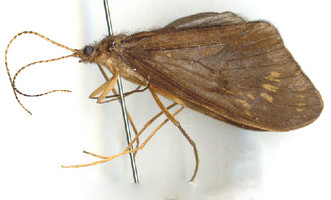Odontoceridae
Ralph W. Holzenthal, Roger J. Blahnik, Aysha Prather, and Karl Kjer


This tree diagram shows the relationships between several groups of organisms.
The root of the current tree connects the organisms featured in this tree to their containing group and the rest of the Tree of Life. The basal branching point in the tree represents the ancestor of the other groups in the tree. This ancestor diversified over time into several descendent subgroups, which are represented as internal nodes and terminal taxa to the right.

You can click on the root to travel down the Tree of Life all the way to the root of all Life, and you can click on the names of descendent subgroups to travel up the Tree of Life all the way to individual species.
For more information on ToL tree formatting, please see Interpreting the Tree or Classification. To learn more about phylogenetic trees, please visit our Phylogenetic Biology pages.
close boxIntroduction
In earlier days, the family was considered a “section” of Leptoceridae (e.g., Walker) or as a subfamily of Leptoceridae (e.g., Ulmer), but later workers considered Odontocerinae Wallengren (1891) to be a distinct family. The family contains about 115 extant species in 14 genera, scattered about the Old and New Worlds. Four genera are endemic to North America, 3 in the West (Namamyia Banks, Nerophilus Banks, and Parthina Denning) and 1 in the East (Pseudogoera Carpenter). Of the 2 additional genera found in North America, Marilia Müller reaches its greatest diversity in the Neotropics (ca. 45 species), with additional species in China, Southeast Asia, and Australia, and Psilotreta Banks occurs in eastern North America, India, Nepal, Southeast Asia, China, Korea, and Japan. In addition to many species of Marilia, the Neotropics harbors 2 endemic monotypic genera, both from southeastern Brazil, Barypenthus Burmeister and Anastomoneura Huamantinco and Nessimian. The Australasian fauna is poorly represented by only a couple of species of Marilia and 2 species of the endemic genus Barynema Banks. Southeast Asia is home to 2 endemic genera, Inthanopsyche Malicky and Lannapsyche Malicky, in addition to those mentioned above. Only the nominotypical genus, Odontocerum Leach, occurs in Europe. The family is not known from Africa, but a single monotypic genus with equivocal placement in the family (Neboiss 1978) was described from the Seychelles, Leptodermatopteryx Ulmer. Larvae live in springs and small to medium-sized streams and rivers, some are associated with waterfalls. They seem to prefer slow flowing areas or depositional zones, where they may burrow in the sandy substrate. Cases are made of sand grains or larger mineral fragments and are very resistant to crushing due to reinforcing silken mortar applied by the larva between sand grains. Larvae are omnivorous, feeding on organic detritus, vascular plants, moss, and algae as well as aquatic arthropods. (From Holzenthal et al., 2007)
References
Holzenthal R.W., Blahnik, R.J., Prather, A.L., and Kjer K.M. 2007. Order Trichoptera Kirby 1813 (Insecta), Caddisflies. In: Zhang, Z.-Q., and Shear, W.A. (Eds). 2007 Linneaus Tercentenary: Progress in Invertebrate Taxonomy. Zootaxa. 1668:639–698.
Wallengren, H.D.J. (1891) Skandinaviens Neuroptera. Andra afdelningen. Svenska Akademien Handlingar, 24, 1–173.
Title Illustrations

| Scientific Name | Barypenthus concolor |
|---|---|
| Specimen Condition | Dead Specimen |
| Life Cycle Stage | Adult |
| View | Lateral |
| Source Collection | Barcode of Life Database (BOLD) |
| Scientific Name | Psilotreta lobopennis |
|---|---|
| Specimen Condition | Dead Specimen |
| Life Cycle Stage | Larva |
| View | Lateral |
| Source Collection | Barcode of Life Database (BOLD) |
About This Page
Ralph W. Holzenthal

University of Minnesota, St. Paul, Minnesota, USA
Roger J. Blahnik

University of Minnesota, St. Paul, Minnesota, USA
Aysha Prather

Centre for Biodiversity and Conservation Biology, Royal Ontario Museum, Toronto, Ontario, Canada
Karl Kjer

Rutgers University, New Brunswick, New Jersey, USA
Correspondence regarding this page should be directed to Ralph W. Holzenthal at , Roger J. Blahnik at , Aysha Prather at , and Karl Kjer at
Page copyright © 2010 Ralph W. Holzenthal, Roger J. Blahnik, Aysha Prather, and Karl Kjer
 Page: Tree of Life
Odontoceridae.
Authored by
Ralph W. Holzenthal, Roger J. Blahnik, Aysha Prather, and Karl Kjer.
The TEXT of this page is licensed under the
Creative Commons Attribution-NonCommercial-ShareAlike License - Version 3.0. Note that images and other media
featured on this page are each governed by their own license, and they may or may not be available
for reuse. Click on an image or a media link to access the media data window, which provides the
relevant licensing information. For the general terms and conditions of ToL material reuse and
redistribution, please see the Tree of Life Copyright
Policies.
Page: Tree of Life
Odontoceridae.
Authored by
Ralph W. Holzenthal, Roger J. Blahnik, Aysha Prather, and Karl Kjer.
The TEXT of this page is licensed under the
Creative Commons Attribution-NonCommercial-ShareAlike License - Version 3.0. Note that images and other media
featured on this page are each governed by their own license, and they may or may not be available
for reuse. Click on an image or a media link to access the media data window, which provides the
relevant licensing information. For the general terms and conditions of ToL material reuse and
redistribution, please see the Tree of Life Copyright
Policies.
- First online 17 July 2010
- Content changed 20 July 2010
Citing this page:
Holzenthal, Ralph W., Roger J. Blahnik, Aysha Prather, and Karl Kjer. 2010. Odontoceridae. Version 20 July 2010 (under construction). http://tolweb.org/Odontoceridae/14590/2010.07.20 in The Tree of Life Web Project, http://tolweb.org/









 Go to quick links
Go to quick search
Go to navigation for this section of the ToL site
Go to detailed links for the ToL site
Go to quick links
Go to quick search
Go to navigation for this section of the ToL site
Go to detailed links for the ToL site